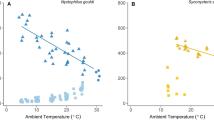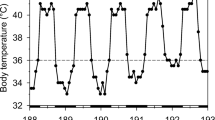Abstract
The expression of heterothermy in the African lesser bushbaby, Galago moholi, seems to be strikingly different to most other heterotherms: G. moholi uses its ability to enter torpor only rarely and torpor is only used by a small fraction of the population. The aim of this study was, therefore, to summarize the parameters of torpor use in G. moholi to conclude the general patterns and discuss them in comparison to other heterotherms to elucidate possible causes and constraints that underlie these differences in deployment of heterothermy. Our study was carried out on wild animals using temperature loggers and open-flow respirometry for measurements of body temperature and metabolic rate, respectively. G. moholi uses torpor only as a last resort and not as a routine, seasonal behavior. Nevertheless, we found that the general physiological patterns of torpor, e.g., torpor bout duration or entry and arousal times from torpor, were mainly consistent with those described for other nocturnal daily heterotherms. The greatest difference found was the unusual low rewarming rates during arousal from torpor, probably due to already depleted internal energy stores and thus inability to mobilize sufficient energy for endogenous heating. We therefore conclude that while general physiological parameters of heterothermy seem to have remained conserved in heterotherms, the underlying causes which elicit this physiological response, and thus the extent of expression and timing of heterothermy, have evolved very differently in different groups, depending on body mass and the specific habitat and lifestyle of the species.




Similar content being viewed by others
Explore related subjects
Discover the latest articles and news from researchers in related subjects, suggested using machine learning.References
Bearder S, Martin R (1980) Acacia gum and its use by bushbabies, Galago senegalensis (Primates: Lorisidae). Int J Primatol 1:103–128
Bieber C, Ruf T (2009) Summer dormancy in edible dormice (Glis glis) without energetic constraints. Naturwissenschaften 96:165–171
Blanco M, Rahalinarivo V (2010) First direct evidence of hibernation in an eastern dwarf lemur species (Cheirogaleus crossleyi) from the high-altitude forest of Tsinjoarivo, central-eastern Madagascar. Naturwissenschaften 97:945–950
Cannon B, Nedergaard J (2004) Brown adipose tissue: function and physiological significance. Physiol Rev 84:277–359
Dausmann KH (2008) Hypometabolism in primates: torpor and hibernation. In: Lovegrove BG, McKechnie AE (eds) Hypometabolism in animals: hibernation, torpor and cryobiology. Interpak, Pietermaritzburg, pp 327–336
Dausmann KH, Glos J, Ganzhorn JU, Heldmaier G (2004) Physiology: hibernation in a tropical primate. Nature 429:825–826
Dausmann KH, Glos J, Ganzhorn JU, Heldmaier G (2005) Hibernation in the tropics: lessons from a primate. J Comp Physiol B 175:147–155
Dausmann KH, Glos J, Heldmaier G (2009) Energetics of tropical hibernation. J Comp Physiol B 179:345–357
Dausmann KH, Nowack J, Kobbe S, Mzilikazi N (2012) Afrotropical heterothermy: a continuum of possibilities. In: Ruf T, Bieber C, Arnold W, Millesi E (eds) Living in a seasonal world: thermoregulatory and metabolic adaptations: 14th Hibernation Symposium. Springer, Berlin
Fietz J, Schlund W, Dausmann KH, Regelmann M, Heldmaier G (2004) Energetic constraints on sexual activity in the male edible dormouse (Glis glis). Oecologia 138:202–209
Geiser F (1998) Evolution of daily torpor and hibernation in birds and mammals: importance of body size. Clin Exp Pharmacol Physiol 25:736–740
Geiser F (2004) Metabolic rate and body temperature reduction during hibernation and daily torpor. Annu Rev Physiol 66:239–274
Geiser F, Baudinette R (1988) Daily torpor and thermoregulation in the small dasyurid marsupials Planigale gilesi and Ningaui yvonneae. Aust J Zool 36:473–481
Geiser F, Baudinette RV (1990) The relationship between body mass and rate of rewarming from hibernation and daily torpor in mammals. J Exp Biol 151:349–359
Geiser F, Drury RL (2003) Radiant heat affects thermoregulation and energy expenditure during rewarming from torpor. J Comp Physiol B 173:55–60
Geiser F, Kenagy GJ (1990) Development of thermoregulation and torpor in the golden-mantled ground squirrel Spermophilus saturatus. J Mammal 71:286–290
Geiser F, Baudinette RV, McMurchie EJ (1986) Seasonal changes in the critical arousal temperature of the marsupial Sminthopsis crassicaudata correlate with the thermal transition in mitochondrial respiration. Cell Mol Life Sci 42:543–547
Grigg G, Beard L, Augee M (2004) The evolution of endothermy and its diversity in mammals and birds. Physiol Biochem Zool 77:982–997
Heldmaier G, Ortmann S, Elvert R (2004) Natural hypometabolism during hibernation and daily torpor in mammals. Respir Physiol Neurobiol 141:317–329
Kobbe S, Dausmann KH (2009) Hibernation in Malagasy mouse lemurs as a strategy to counter environmental challenge. Naturwissenschaften 96:1221–1227
Kobbe S, Ganzhorn J, Dausmann K (2011) Extreme individual flexibility of heterothermy in free-ranging Malagasy mouse lemurs (Microcebus griseorufus). J Comp Physiol B 181:165–173
Lahann P (2007) Biology of Cheirogaleus major in a littoral rain forest in Southeast Madagascar. Int J Primatol 28:895–905
Lahann P, Dausmann K (2011) Live fast, die young: flexibility of life history traits in the fat-tailed dwarf lemur (Cheirogaleus medius). Behav Ecol Sociobiol 65:381–390
Lovegrove BG (2012) The evolution of endothermy in Cenozoic mammals: a plesiomorphic-apomorphic continuum. Biol Rev 87:128–162
Lovegrove BG, Génin F (2008) Torpor and hibernation in a basal placental mammal, the lesser hedgehog tenrec Echinops telfairi. J Comp Physiol B 178:691–698
Luo Z-X (2007) Transformation and diversification in early mammal evolution. Nature 450:1011–1019
Mzilikazi N, Masters JC, Lovegrove B (2006) Lack of torpor in free-ranging southern lesser galagos, Galago moholi: ecological and physiological considerations. Folia Primatol 77:465–476
Nicol SC, Andersen NA (2008) Rewarming rates and thermogenesis in hibernating echidnas. Comp Biochem Physiol A 150:189–195
Nicol SC, Andersen NA, Arnold W, Ruf T (2009) Rewarming rates of two large hibernators: comparison of a monotreme and a eutherian. J Therm Biol 34:155–159
Nowack J, Mzilikazi N, Dausmann KH (2010) Torpor on demand: heterothermy in the non-lemur primate Galago moholi. PloS ONE 5:e10797
Nowack J, Wippich M, Mzilikazi N, Dausmann KH (2012) Surviving the cold, dry period in Africa: behavioral adjustments as an alternative to heterothermy in Galago moholi. Int J Primatol. http://dx.doi.org/10.1007/s10764-012-9646-8
Ortmann S, Heldmaier G, Schmid J, Ganzhorn JU (1997) Spontaneous daily torpor in Malagasy mouse lemurs. Naturwissenschaften 84:28–32
Pullen SL, Bearder SK, Dixson AF (2000) Preliminary observations on sexual behavior and the mating system in free-ranging lesser galagos (Galago moholi). Am J Primatol 51:79–88
Racey P, Swift S (1981) Variations in gestation length in a colony of pipistrelle bats (Pipistrellus pipistrellus) from year to year. J Reprod Fertil 61:123–129
Schmid J (2000) Daily torpor in the gray mouse lemur (Microcebus murinus) in Madagascar: energetic consequences and biological significance. Oecologica 123:175–183
Schmid J, Speakman JR (2000) Daily energy expenditure of the grey mouse lemur (Microcebus murinus): a small primate that uses torpor. J Comp Physiol B 170:633–641
Schmid J, Speakman J (2009) Torpor and energetic consequences in free-ranging grey mouse lemurs (Microcebus murinus): a comparison of dry and wet forests. Naturwissenschaften 96:609–620
Schmid J, Ruf J, Heldmaier G (2000) Metabolism and temperature regulation during daily torpor in the smallest primate, the pygmy mouse lemur (Microcebus myoxinus) in Madagascar. J Comp Physiol B 170:59–68
Tomlinson S, Withers PC, Cooper C (2007) Hypothermia versus torpor in response to cold stress in the native Australian mouse Pseudomys hermannsburgensis and the introduced house mouse Mus musculus. Comp Biochem Phys A 148:645–650
Wein J (2010) Effects of ambient temperature on tropical hibernation in the lesser hedgehog tenrec, Echinops telfairi. Department of Biology, University of Hamburg, Hamburg
Wilde CJ, Knight CH, Racey PA (1999) Influence of torpor on milk protein composition and secretion in lactating bats. J Exp Zool 284:35–41
Acknowledgments
We thank the Limpopo Province Department of Agriculture and Environment for their hospitality and permission to work at Nylsvley Nature Reserve. All procedures in this study complied with the “Principles for animal care”, publication no. 86–23, revised 1986 (National Institute of Health) and the “Code of ethics for animal experimentation” manual adopted by the Nelson Mandela Metropolitan University (animal ethics clearance no. A09-SCI-ZOO-001). Animals were captured under permit no. CPM-002-00003, issued by the Department of Economic Development, Environment and Tourism. Nangamso Thole, Lebogang Johanna Selomo, and Lucas Mamanyane provided invaluable assistance in the field. Financial support was received from the Deutscher Akademischer Austauschdienst and the Deutsche Forschungsgemeinschaft (DA 1031/3-1/2).
Author information
Authors and Affiliations
Corresponding author
Additional information
Communicated by G. Heldmaier.
Rights and permissions
About this article
Cite this article
Nowack, J., Mzilikazi, N. & Dausmann, K.H. Torpor as an emergency solution in Galago moholi: heterothermy is triggered by different constraints. J Comp Physiol B 183, 547–556 (2013). https://doi.org/10.1007/s00360-012-0725-0
Received:
Revised:
Accepted:
Published:
Issue Date:
DOI: https://doi.org/10.1007/s00360-012-0725-0




